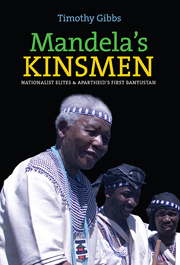Book contents
- Frontmatter
- Contents
- List of Maps and Figures
- Acknowledgements
- List of Abbreviations
- Introduction: Mandela' Kinsmen
- 1 Education, Monarchy & Nationalism
- 2 The First Bantustan, 1954–1963
- 3 The Second Peasants' Revolt, Mpondoland 1960–1980
- 4 The Old Mission Schools, 1963–1980
- 5 The Comrade-King, Bantustan Politics 1964–1980
- 6 Chris Hani's Guerrillas, 1974–1987
- 7 The Apartheid Endgame, 1987–1996
- 8 The New South Africa & Transkei's Collapse, 1990 onwards
- Conclusion: African Nationalism & its Fragments
- Bibliography
- Index
7 - The Apartheid Endgame, 1987–1996
Published online by Cambridge University Press: 05 April 2014
- Frontmatter
- Contents
- List of Maps and Figures
- Acknowledgements
- List of Abbreviations
- Introduction: Mandela' Kinsmen
- 1 Education, Monarchy & Nationalism
- 2 The First Bantustan, 1954–1963
- 3 The Second Peasants' Revolt, Mpondoland 1960–1980
- 4 The Old Mission Schools, 1963–1980
- 5 The Comrade-King, Bantustan Politics 1964–1980
- 6 Chris Hani's Guerrillas, 1974–1987
- 7 The Apartheid Endgame, 1987–1996
- 8 The New South Africa & Transkei's Collapse, 1990 onwards
- Conclusion: African Nationalism & its Fragments
- Bibliography
- Index
Summary
‘A military intelligence project that went wrong’?
String-pulling and elite political manoeuvring worked both ways. A counter-coup against Stella Sigcau's Bantustan government was brewing within the Transkei Defence Force. Her ‘apparent ANC sympathies’ were causing ‘considerable consternation’. On the penultimate day of 1987, a young officer, Brigadier Bantu Holomisa, toppled Sigcau. The interregnum had lasted less than 90 days. A week later, Kaiser Matanzima telexed the apartheid government in Pretoria: ‘Military takeover peaceful. South Africa citizens safe and happy. Transkeians joyful.’
Tumbled into power aged only 33, Bantu Holomisa's meteoric rise owed much to the militarisation of Bantustan politics. He rose through the ranks of the Transkei Defence Force at a time when Pretoria's securocrats were constructing a formidable array of African armed forces to fight the black liberation movements and solidify apartheid rule, not only in South Africa but across the southern African region. During the 1980s, a web of Bantustan armies and security police, African vigilante groups, and secretive ‘Third Force’ proxies had fought a low key counterinsurgency against the liberation movements in the Homelands. By the time Holomisa came to power, these conflicts had exploded into the open. A state of near civil war consumed some Bantustans, particularly in KwaZulu and Natal, where political violence would claim over 11,000 lives. Nevertheless, having come to power with the benediction of Kaiser Matanzima, Holomisa achieved the astonishing feat of changing horses in midstream. He switched his support, becoming one of the most popular politicians in South Africa when he turned Transkei into a stronghold that supported the liberation movements. Holomisa's meteoric rise was framed by southern Africa's insurgencies and counterinsurgencies.
- Type
- Chapter
- Information
- Mandela's KinsmenNationalist Elites and Apartheid's First Bantustan, pp. 131 - 154Publisher: Boydell & BrewerPrint publication year: 2014



